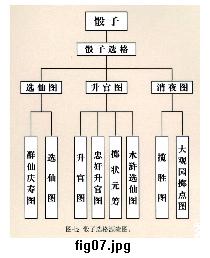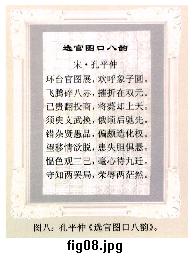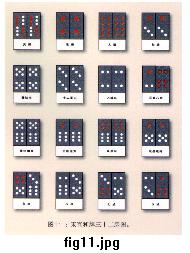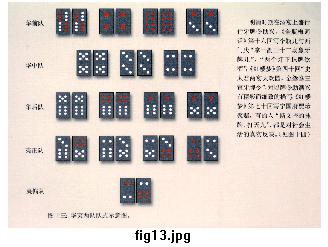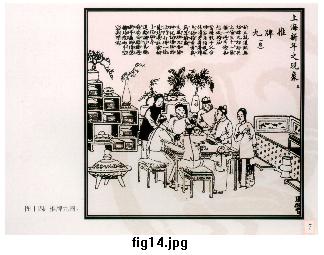Figure 1. John Low writes:
Figure 1 (first half).
The single large character at the top is "Bo". "Bo" refers to
the extremely ancient board game/s played by Chinese people long long
long ago, even older than Go and Chinese Chess. "Bo" is split into
2 different games: "Da Bo" (BIG Bo) and "Xiao Bo"
(LITTLE Bo).
Virtually nothing is known about the rules of "Big Bo" apart from
the fact that it uses 12 pieces (6 per person) and "Liu Zhu"
(SIX Zhu). "Zhu" is an old fashioned character for chopsticks,
in Japanese pronounced "Hashi". But in this context, "Zhu" is a
long thin bamboo object thrown to indicate a number (similar to a
YES/NO eraser), hence there are 6 of them. I assume each of these six
"Zhu" have a marking on them.
Much more is known about "Xiao Bo". Each person also starts off
with 6 pieces. The board is 12 rows/columns long (I think) and instead
of "Liu Zhu" thrown used for number indication, two ugly items are
rolled. These two ugly wooden dice are called "Er Qiong" which
means "TWO Qiong". They look like funny soccerballs or
dodecahedrons. The pieces move according the rolls and they upgrade at
a certain point. The upgraded pieces can either proceed to the final
destination, or attack the opponent's pieces. "Little Bo" is very
similar to Backgammon.
Later on, a few modifications were made to the "Two Qiong", and
they were called "Qiong" (the character below the other one)
again. The new "Qiong" is now made of stone or jade, and had a few
less faces. Note that the Qiong in "Two Qiong" and "Qiong" are
two completely different characters, but having the same sound,
homophones.
The "Six Zhu" for the "Big Bo" game was later replaced by "Wu
Mu" which means "FIVE Woods". These are now 5 flat pieces
of wood, one side is painted black with a little cow carved on it, the
other side is painted white with a wild chicken carved on it.
The "Five Woods" itself can be used for a new game called "CHU
PU" (the one to the left of five woods in the diagram). This game
involves awarding points according to the number attained by tossing
the "Five Woods", and is therefore gambling orientated.
Over time, Chinese people stopped using "Five Woods" or "Qiong"
and merged them together to form convenient, normal 6 sided dice. It is
said that the person who initiated this change was Cao Zhi, one of Cao
Cao's sons (Cao Cao was one of the main kings during the Three
Kingdoms Period 200-280 AD).
Also, the popular reason as to why "4" on Chinese dice is red, is
because one of the Kings during the Tang Dynasty (618-907AD) was
playing a gambling dice game with someone. And the King rolled 6 dice,
requiring exactly 2 of them to be "4" in order to win big money.
And it did occur, and the King was very happy, so he decreed that all
of the 4's be painted red representing good luck.
Ironically, this conflicts with ordinary Chinese and Japanese thinking
that the number "4" is bad because it sounds like "si/shi"
which can mean "Death".
Second half of FIGURE 1:
I'll start from the left branch. The one just to the right of
"Qiong" is "SHI Pai" which means "Poetry
Pai". During the Tang Dynasty, Chinese poetry was very popular
among everybody. Whenever people were creating a new poem or trying to
copy one down for reciting, they would write it on a rectangular piece
of wood. Later on, people decided to play a game with "Poetry
Pai". A deck of wooden pieces had a short phrase written on them.
Friends when playing this game would each draw a Poetry piece and then
complete the phrase by making a short poem right on the spot for
"fun". Later on again, "Poetry Pai" was used
for playing a tricks game (eg Bridge) among the intelligent/literate. I
have absolutely no idea how this works (no explanation anywhere).
In the Northern Song Dynasty (960-1127), the poetry theme for these Pai
were eliminated, however the tricks like game stayed. The new makeover
was supposedly created by a government official in the 2nd year of King
Hui Zong's rule. These new bone/ivory Pai were called "XUAN
HE pai". They look like dominoes, with a total of 227 pips, there
are 32 of these dominoes, and are meant to be lousy representations of
certain star constellations.
The most popular tricks game that developed using "Xuan He
Pai" was called "Dou Tian Jiu", which means
"FIGHTING SKY/HEAVEN'S NINE". "Xuan He
Pai" today is usually called "TIAN JIU PAI" due to
the past huge popularity of "Dou Tian Jiu". This game is
still played today in China, Hong Kong and Taiwan and some companies
still make these dominoes, but they are definitely not as popular as
real mahjong or Big Two (a modern Chinese card game) etc.
Rules for "Dou Tian Jiu" can be found at
http://www.pagat.com/multitrk/tiengow.html
For the second branch, the one to the right of "Shi Pai" is
now "YE ZI" which means "Leaves". This game was
actually a gambling dice game using 6 dice and the "Leaves"
were just pieces of paper in which people wrote down what the numbers
were thrown, who gets what score etc. Later on when this game
wasn't played, "Ye Zi" just was an alternative word
for "Playing Cards". For example, the Chinese term for
Japanese Hanafuda cards would be "Ri Ben Ye Zi Pai"
(Japanese Leaves Pai).
The one below "Ye Zi" is "Ye Zi JIU pai" which
means "Leaves Wine/Beer Pai". This is one of those early
Chinese prototype card decks containing various suits (not familiar)
and is a silly adults only drinking game. "Ye Zi Jiu Pai"
is part of the "Jiu Ling" strand of old Chinese games. In
all "Jiu Ling" games, whoever loses has to drink a cup of
wine/beer. And the person who is the least drunk at the end is the
overall winner.
I think you already know a significant amount about "Ma
Tiao" but I shall say some about it. It is a deck of 40 cards,
primarily containing Wan (10,000's), Suo zi (money ropes), Wen
Xian (a different money ropes) and some other strange cards. This is a
tricks game again, and is for 4 players. Each person is dealt out 8
cards with 8 cards unused in the middle of the table. The 3 non dealers
attempt to get rid of the dealer by playing more valuable cards than
him (I think).
"Zhi Pai" is "PAPER pai" and is an edited
version of the cards used in "Ma Tiao". This IS a rummy
like game (NOT a tricks game) and was originally using 2 decks of the
30 money cards. It was a 4 player game and you need 3 Sequences + 1
pair in order to win. People thought 2 decks wasn't enough, so it
was increased to 4 decks of 30 money cards = 120 cards in total.
Triples and Quads were now allowed, and you still only needed 3 Groups
+ 1 pair in order to win. Real mahjong is different as it uses 4 groups
+ 1 pair.
The alternative name for "Zhi Pai" is "Peng He
Pai". I'm not sure if they were allowed to meld/win off
other people's discards though, or if deadwood (as in Gin Rummy)
was allowed too.
Thanks also to Cofa Tsui for contributing to the annotated image.
|







